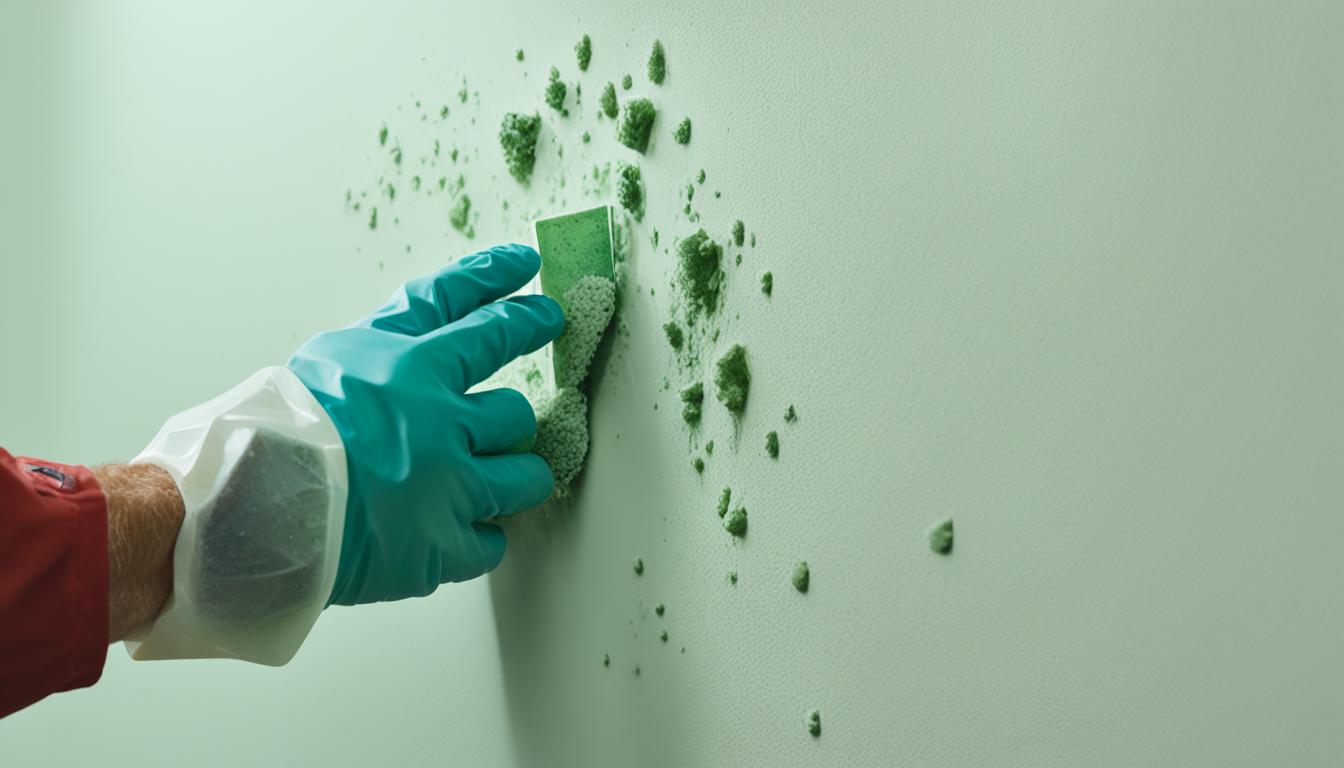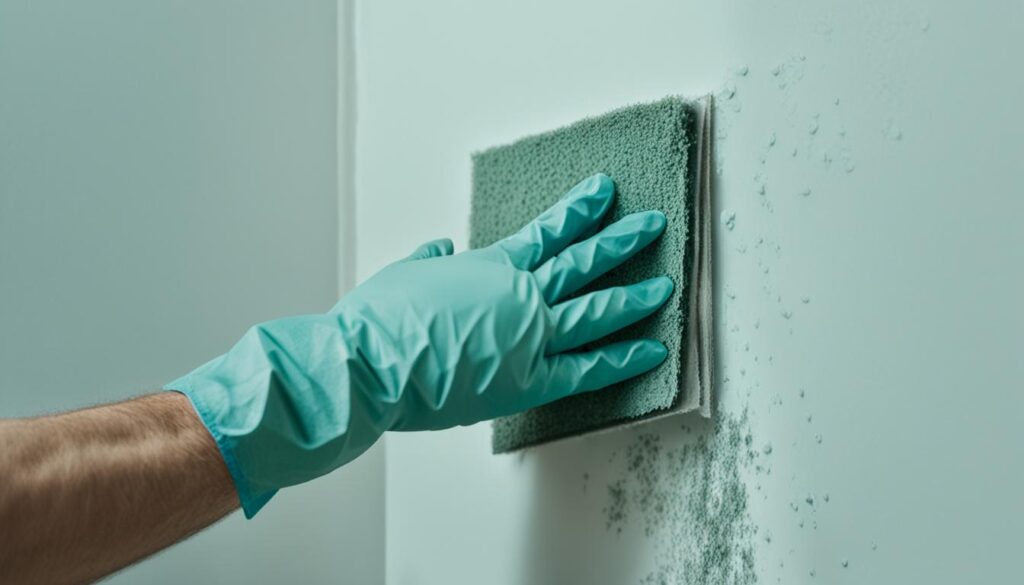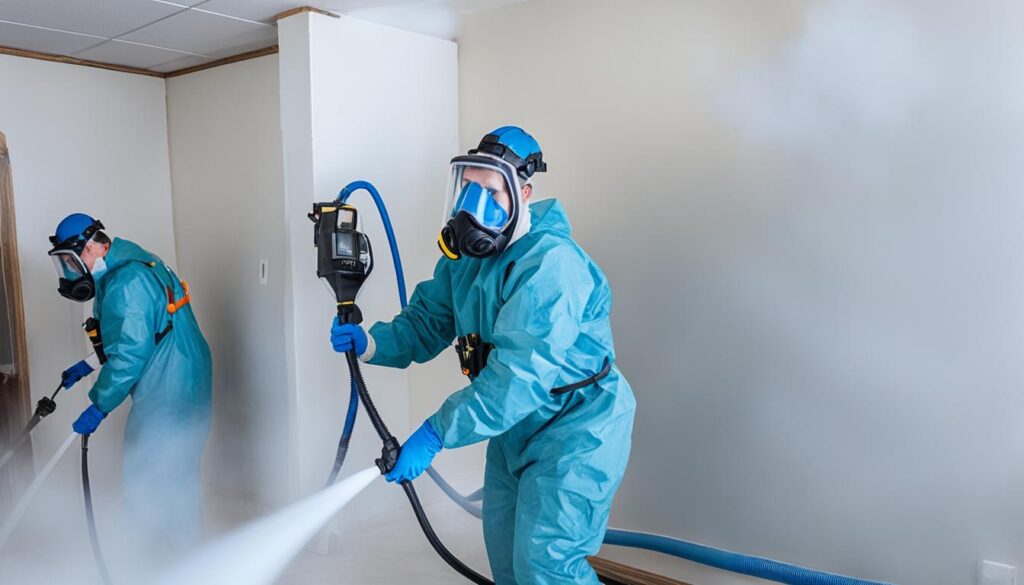
Mold Removal from Drywall: Expert Tips & Steps
Welcome to our comprehensive guide on mold removal from drywall. In this article, we will provide you with expert tips and step-by-step instructions to effectively eliminate mold and ensure a safe and thorough cleanup process. Mold growth on drywall can be a serious issue, causing health hazards and structural damage. By following the right techniques and precautions, you can safeguard your home and create a healthier living environment. Let’s dive in!
Key Takeaways:
- Effectively removing mold from drywall requires expert tips and step-by-step instructions.
- Mold growth on drywall can be prevented by understanding its common causes and identifying its presence.
- Follow the detailed steps for mold removal to ensure a thorough cleanup process.
- In some cases, professional mold remediation services may be necessary for effective and comprehensive removal.
- Prioritize safety throughout the mold removal process and consider professional help when needed.
Understanding Mold Growth on Drywall
Before diving into the removal process, it’s important to understand how mold grows on drywall. By gaining insight into the causes and signs of mold growth, you can take proactive measures to prevent its recurrence in the future.
Common Causes of Mold Growth on Drywall:
- Persistent moisture: Excessive humidity or water leaks that penetrate the drywall surface can create an ideal environment for mold growth.
- Poor ventilation: Insufficient airflow and inadequate ventilation systems can contribute to increased moisture levels, promoting mold growth.
- Condensation: Cold surfaces in humid areas can cause moisture to condense, providing a breeding ground for mold on drywall.
Identifying Mold Presence on Drywall:
- Visible signs: Pay attention to any discoloration, spots, or patches on the drywall surface, as these may indicate the presence of mold.
- Musty odor: Mold often emits a distinct musty smell, which can help identify its presence, especially in enclosed spaces.
- Allergic reactions: If household members experience unexplained allergies or respiratory issues, mold contamination could be a potential cause.
By familiarizing yourself with these causes and signs of mold growth on drywall, you can promptly address any issues and take preventive measures to safeguard your home. Remember, early detection and prevention are key to maintaining a mold-free environment.
Steps for Mold Removal from Drywall
Removing mold from drywall requires careful steps to ensure effective elimination and prevent further damage. Follow these expert tips and techniques to safely and successfully remove mold from your drywall.
Step 1: Prepare the Area
Before starting the mold removal process, it’s essential to take proper precautions to protect yourself and your surroundings. Wear protective clothing, gloves, and a mask to prevent exposure to mold spores. Seal off the affected area with plastic sheets to contain any airborne spores during the cleanup.
Step 2: Identify the Source
Before removing mold from your drywall, it’s crucial to identify and address the underlying cause of the mold growth. Check for any water leaks, moisture intrusion, or plumbing issues that could be contributing to the mold problem. Resolving the source of moisture will prevent future mold growth.
Step 3: Remove Affected Materials
Begin by carefully removing any visible mold on the drywall surface. Use a scrub brush or a sponge soaked in a mold removal solution to clean the affected areas. If the mold has deeply penetrated the drywall, it may be necessary to remove and replace the affected sections. Dispose of the removed materials in tightly sealed bags to prevent cross-contamination.
Step 4: Clean and Disinfect
After removing the mold-infested materials, thoroughly clean the surrounding surfaces with a mold-specific cleaner. Be sure to follow the manufacturer’s instructions for proper application and contact time. Once the areas are cleaned, use a disinfectant to kill any remaining mold spores and prevent regrowth.
Step 5: Dry the Area
Properly drying the affected area is crucial to prevent the growth of mold and mildew in the future. Use dehumidifiers, fans, and adequate ventilation to ensure complete drying. Monitor the moisture levels in the room and ensure they remain below 55% to discourage mold growth.
Incorporating these steps into your mold removal process will help you effectively eliminate mold from drywall while safeguarding your home from further damage. Remember, if the mold infestation is extensive or recurring, it’s best to seek professional assistance for thorough mold remediation and preventing future outbreaks.

Professional Mold Remediation Services
While DIY mold removal can be done in some cases, certain situations may require professional assistance. Hiring a professional mold remediation service offers numerous benefits and ensures a thorough and successful cleanup. Professionals have the expertise, experience, and specialized equipment to handle mold removal effectively, minimizing the risk of further contamination and damage to your property.
When choosing a professional mold remediation service, it’s important to look for certain qualifications. Verify that they are licensed and certified in mold remediation, as this demonstrates their commitment to following industry best practices and safety protocols. Additionally, check for insurance coverage, which provides protection in case of any accidents or damages that may occur during the remediation process.
Professional mold remediation services offer a range of advantages over DIY methods. They have the knowledge to assess the extent of mold growth accurately, including hidden or hard-to-reach areas. Through thorough inspections and testing, they can identify the underlying causes of mold growth and implement effective solutions to prevent future occurrences.
“Hiring a professional ensures that all mold colonies are completely eradicated, reducing the risk of regrowth and associated health issues.” – Dr. Natalie Thompson, Mold Specialist
Furthermore, professional mold remediation services have access to advanced equipment and technologies that enable them to conduct a comprehensive cleaning process. They use industry-approved techniques to safely remove mold from affected areas, including drywall, and ensure that no spores or contaminants are left behind. This helps create a healthier indoor environment and reduces the likelihood of mold-related health problems.
Mold remediation professionals also prioritize safety throughout the process. They adhere to strict safety guidelines and use appropriate personal protective equipment (PPE) to protect themselves and the occupants of the property. By entrusting the mold removal process to professionals, you can have peace of mind knowing that the cleanup is being handled with the utmost care and precaution.
Benefits of Professional Mold Remediation Services
| Benefits | Explanation |
|---|---|
| Expertise and Experience | Professionals possess the necessary knowledge and experience to address mold issues effectively. |
| Thorough and Successful Cleanup | Professionals ensure complete mold removal and implement preventive measures to prevent future growth. |
| Advanced Equipment and Technologies | Professionals have access to specialized tools and techniques to perform a comprehensive cleaning process. |
| Safety and Compliance | Professionals follow safety guidelines and use proper PPE to protect themselves and the property’s occupants. |
In summary, hiring a professional mold remediation service offers numerous advantages over attempting to remove mold yourself. Their expertise, experience, and specialized equipment ensure a thorough and successful cleanup while prioritizing safety. By choosing professional mold remediation services, you can achieve a mold-free environment and safeguard the health and well-being of your home or business.

Conclusion
In conclusion, mold removal from drywall is a crucial process that should not be taken lightly. Mold growth on drywall can pose significant health risks and cause damage to your home. By following the expert tips and step-by-step instructions outlined in this article, you can effectively remove mold from your drywall and create a safer living environment for you and your family.
It is important to prioritize safety throughout the mold removal process. Wear protective gear such as gloves, goggles, and a mask to prevent exposure to mold spores. Properly ventilate the area and dispose of contaminated materials in sealed bags. Make sure to thoroughly clean and dry the affected surfaces to prevent any regrowth.
While DIY mold removal can be appropriate for small and isolated cases, larger or recurring mold problems may require professional assistance. A professional mold remediation service has the expertise, equipment, and experience to handle complex mold situations, ensuring a thorough and successful cleanup. It is always advisable to seek professional help if you are unsure or if the mold problem is extensive.
For mold assessment services in Florida, contact Fix Mold Miami at 305-465-6653. Their team of experts can provide comprehensive mold inspections, testing, and effective remediation solutions to protect your home and your health.




